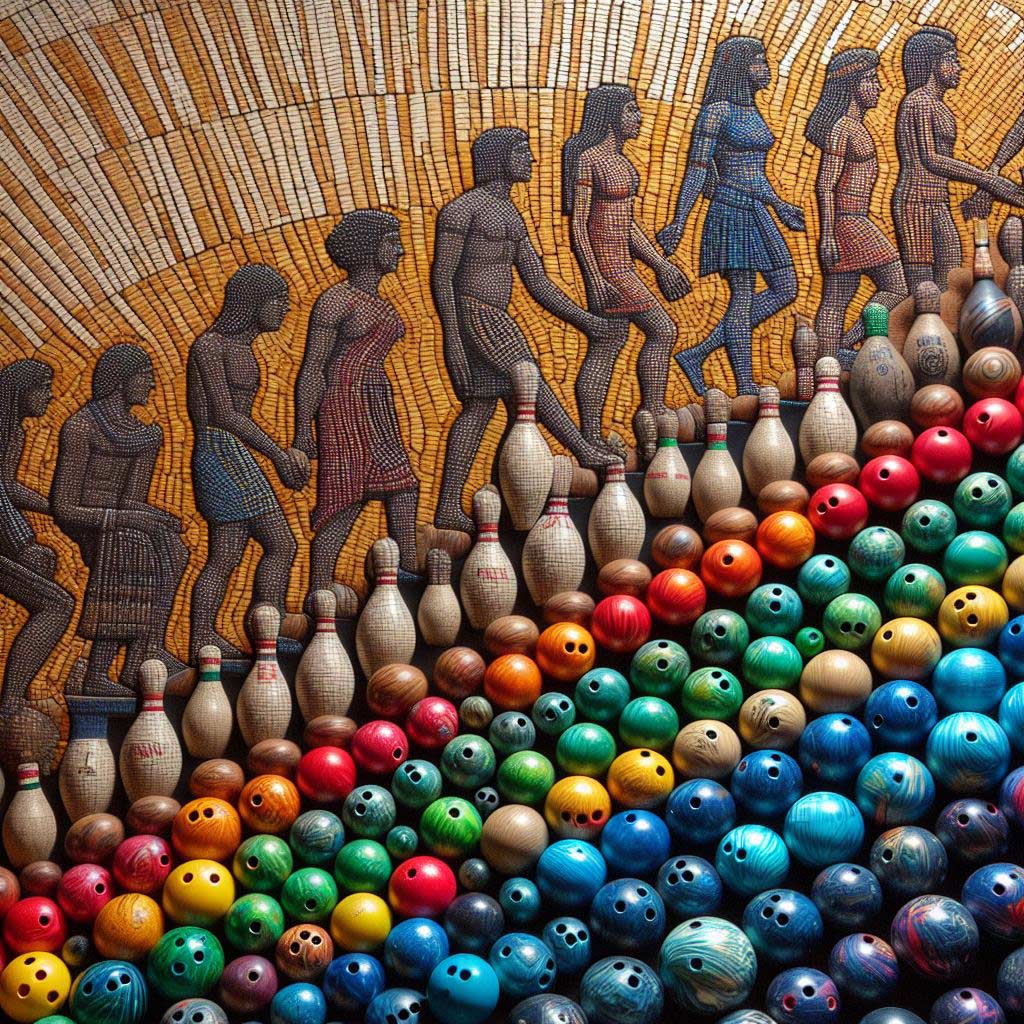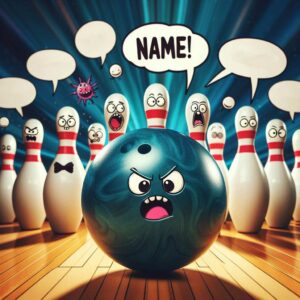Bowling is now one of the most popular sports in the world, with over 70 million Americans heading to their local bowling alleys to roll strikes in 2021 alone.
With major tournaments offering million-dollar prizes, appearances from celebrity bowlers, and championships broadcast on ESPN, it’s clear bowling has established itself as a professional sport.
But it wasn’t always this way.
Bowling has a long and storied history that traces back thousands of years. This beloved activity actually began as a lawn game played by peasants and commoners.
So how exactly did bowling transform into a revered sporting event with regulated leagues, big-money sponsors, and some of the sport’s most iconic moments?
Let’s roll through the unique history of ten-pin bowling to find out how it strikes as both an enduring pastime and a competitive professional sport.
Bowling’s Early Origins and Popularity
Versions of bowling have been traced back to Ancient Egypt in 3200 BC and even the Roman Empire. But bowling as we essentially know it today arose in Germany in the Middle Ages. The sport consisted of rolling a ball towards objects called kegels, which were clubs set up on end in the grass.
As the pastime spread across Germany and England, peasants and villagers would play an early form of lawn bowling out in the open or in crude indoor alley lanes packed with dirt floors. Bowling balls during the early days were often made from hardwoods like elm so they could withstand being lobbed along the ground.
With rules varying by village and region, bowling started to take hold as a favorite activity amongst commoners and nobility alike by the 13th century.
King Edward III allegedly outlawed lawn bowling to redirect the focus of his troops onto archery practice instead. And a 15th century law from England reveals bowling was also banned for distracting parishioners from church.
While original rules from bowling’s early days are limited, the activity continued to thrive. In fact, King Henry VIII was known to be an avid bowler himself. One of the first indoor bowling greens was actually built for him in 1511, helping bring the pastime inside during poor weather.
Bowling Alleys and League Play Emerge
It wasn’t until the mid-19th century that indoor bowling truly took shape in the United States. As waves of German immigrants brought their penchant for bowling to cities like Milwaukee, Detroit, and New York, early bowling alleys started opening up shop.
The first indoor bowling alley in the US popped up in New York City in 1840 in an underground track below a saloon. Patrons would bet on games using makeshift rules as they rolled balls sometimes made from whalebone along dirt lanes by candlelight.
Over the next several decades, bowling alleys multiplied rapidly across the East Coast and Midwest as they offered a fun and slightly mischievous venue for gambling and drinking. Alleys at the time had a seedy reputation with connections to organized crime rings in big cities.
But in 1895, the creation of the American Bowling Congress (ABC) took big steps at making bowling more standardized and socially acceptable as an organized sport. They established official playing rules, scoring systems, leagues and tournaments. Other regional bowling organizations soon followed.
The early 1900s brought several technological innovations that helped transform bowling into the sport we know today. The first mechanized pinsetter was introduced in 1906, followed by Brunswick’s automatic pinsetter debut in 1946.
Suddenly bowling alleys could be outfitted for automated pin resetting rather than relying on pin boys to manually reset pins each frame.
With automated alleys requiring less intensive labor and upkeep, bowling became even more accessible across socioeconomic lines in the United States. Leagues were increasingly established as both amateur and professional players could participate more easily.
The American Machine and Foundry Corporation (AMF) capitalized on bowling’s rising popularity by rapidly opening mechanized bowling centers across the country under the AMF Bowling brand beginning in the 1950s. Their advances made AMF Bowling the largest operator of giant bowling centers tailored toward league play.
Professional Bowling Tour Emerges Mid-1900s
With bowling leagues and recreational play thriving by the mid-20th century, the next step was for the sport’s top talent to truly turn professional.
The first significant professional bowling tournament, known as the BPAA All-Star, was held in Detroit in 1941. It offered an unheard-of $5,000 first-place prize and drew over 200,000 viewers through live radio broadcasts.
Seeing the potential to bring bowling to a national audience, industry leaders established the Professional Bowlers Association (PBA) in 1958.
Sports entrepreneur Eddie Elias, an avid bowler himself, became the first PBA Commissioner and set the stage for the inaugural PBA Tour’s first event. Top talents like Billy Welu and Buzz Fazio emerged as early bowling stars with fierce rivalry drawing crowds.
A few years later in 1961, the ladies of bowling followed suit with the formation of the Professional Women’s Bowling Association (PWBA) to launch their own competitive tour.
With swaggering professionals, serious cash prizes reaching $25,000 by 1962, and events televised coast-to-coast, the 1960s kicked off what became known as the “Golden Age” of bowling.
The thrilling sport was considered second only to baseball in television ratings at one point with players turned celebrities like Dick Weber becoming household names.
During the peak years of the 1960s and 70s, over ten million Americans were registered in bowling leagues and half the country either bowled regularly or attended a bowling event in the past year.
Pin-drop moments like the iconic “Bowler’s Dream” frame of Earl Anthony rolling three consecutive strikes in the 1977 Firestone Tournament of Champions captivated fans.
For a span of over 30 years, the bowling tour commanded TV ratings that reached an astronomical 20+% audience share during Saturday afternoon broadcasts.
League nights also formed the backdrop for beloved shows like The Honeymooners. Feature films even got in on the craze—who could forget Jeff Bridges’ legendary bowling character The Dude in The Big Lebowski?
Modern State of Bowling as a Professional Sport
While bowling faded from the media spotlight after its mid-century boom, the sport has witnessed a resurgence over the past decade as both a participatory and professional sport.
Today, over 70 million Americans try their hand at knocking down pins at least once per year with two million avid league members nationwide. Bowling remains one of the highest participation sports among all age groups.
The bowling industry now generates over $8 billion in economic activity within the U.S. alone according to research from the Bowling Proprietors’ Association of America (BPAA).
From local houses to giant entertainment venues like participant Michael Jordan’s luxury bowling complex, opening an alley has transformed into a major commercial real estate venture.
On the professional circuit, bowling tournaments have experienced renewed interest as well from younger demographics. Thanks to robust media distribution and advertising partnerships with the PBA Tour’s broadcasting agent FOX Sports, current bowling championships are more accessible to viewers than in the blacked-out days post-1980s.
While TV ratings still pale in comparison to the huge figures of the 60s and 70s, modern tournaments like the U.S. Open draw hundreds of thousands of live online spectators.
Today’s bowling stars like Australia’s Jason Belmonte, the “Stephen Curry of Bowling”, earn over $200,000 a year through competitions and sponsorship deals with brands like Storm.
In tandem with strong amateur participation, bowling’s professional sphere seems primed to continue striking on thanks to its widespread appeal across ages and ability levels meshed with resilientustry advancements.
The sport beloved by Egyptian pharaohs has certainly evolved across thousands of years from a lawn diversion to a multi-billion dollar entertainment machine. But bowling at its core remains an engrossing and obsessively challenging game adored by recreational and competitive players alike.
Conclusion
Tracing back to at least Ancient Egyptian times, bowling morphed from an outdoor peasant pastime into one of the most iconic American sports today.
After technological leaps like automated pinsetters and the establishment of professional tours sparked competitive bowling’s post-WWII “Golden Age”, the sport has recently rebounded with renewed youth interest in both recreational alleys and major televised tournaments.
Bowling’s enduring legacy can be attributed to its simplicity yet incredible difficulty to master. The exciting showdowns made for early radio and TV paved the pathway for modern broadcasts showcasing the latest bowling stars and legends battling it multi-million dollar championships.
So while bowling may have carried somewhat of a roguish stigma through its formative years in the United States, the activity’s early roots and subsequent rise towards beloved professional sport status lives on as millions continue packing into local bowling centers and tuning into thrilling competitions nationwide.
Frequently Asked Questions
How did bowling get started?
Bowling originated as an outdoor lawn game in Ancient Egypt and the Roman Empire before becoming popular in Germany and England during the Middle Ages. Early forms involved rolling balls toward objects called kegels.
Who made bowling a sport?
Bowling was popularized into more organized sporting form through the establishment of official rules, leagues, and associations like the American Bowling Congress (ABC) formed in 1895, along with the introduction of new bowling technology.
What makes bowling a sport?
Key aspects that make bowling a recognized sport include standardized rules and scoring systems, governing bodies overseeing competitions, division of professional and amateur status, tournaments with monetary prizes, player rankings, and technological innovation allowing for accessibility and mass participation.
What are some fun facts about bowling history?
- In 1511 King Henry VIII had one of the first indoor bowling greens built in his palace to play during inclement weather
- The first indoor bowling alley in the United States opened illegally in 1840 below a saloon in New York City
- During bowling’s peak popularity eras, over 31 million Americans were registered in bowling leagues
- Famous bowler Glenn Allison rolled 900 series (three straight 300-point games) years before getting sanctioned for the record
Why are there 10 pins in bowling?
The origin of the standard 10 bowling pins set in a triangle formation is unclear but some records trace it back to mid-18th century Germany. Having 10 pins increased the challenge which added more excitement to matches.
When did bowling become a sport in America?
Bowling became recognized as an organized sport and recreational pastime from the late 1800s/early 1900s based on four key phases: 1) Standardized rules and associations formed starting in 1895 2) the Rise of indoor automated bowling alleys in the early 1900s 3) the Formation of professional bowling tours in the 1950s/60s 4) Mass participation in leagues from 1950-1970s “Golden Age”.
Why did people invent bowling?
Bowling developed over centuries because rolling balls at target objects evolved as a popular game requiring skill amongst both peasants and royalty. Standardization of bowling rules allowed scoring metrics for competition. Later technological advancements automated pinsetting and the building of alleys to make the activity widely accessible.
When was bowling invented and why?
The earliest known forms of bowling date back over 5,000 years ago to Ancient Egypt and Rome as an outdoor game to knock over club targets. The activity spread through Europe during the Middle Ages and arrived in America with German immigrants in the 1800s, continuing to evolve into a modern sports and entertainment business.
How did bowling begin in the US?
German immigrants brought an early bowling game called “Kegelspiel” to the United States in the 1840s. Given the game’s association with drinking and gambling, underground bowling alleys began opening illegally before the activity was later popularized into family recreation centers and leagues by the early 1900s as rules were standardized.





